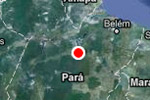A federal judge has suspended the construction of a 1,820 megawatt dam on the Teles Pires River in the Amazon. The judge found that indigenous communities were not properly consulted about the dam, which would flood a sacred site, known as the Seven Waterfalls, as well as imperil the livelihoods of indigenous fishermen.
“The compensation [the government is] offering will never substitute places that are sacred to us, such as Sete Queda [Seven Waterfalls], that hold the cemeteries of our ancestors and that should be preserved. Sete Quedas is also the spawning grounds of fish that are an important source of food. They talk about fish ladders, but where have these ever worked?” Taravy Kayabi, a leader of the indigenous Kayabi people, said in a press release, adding that, “The government needs to look for alternative ways to generate energy that don’t harm indigenous peoples and their territories.”
The judge ordered that the indigenous tribes of the Kayabi, Manduruku, and Apiaká must be consulted before any further construction can occur on the Teles Pires Dam, named after the river. Breaking the suspension will result in a fine of $100,000 per day.
Still, NGOs warn that this is not the end of the Teles Pires Dam.
“What we’ve seen over and over again, in cases such as [the Belo Monte dam], is that the President’s office politically intervenes in regional federal courts to overturn decisions against violations of human rights and environmental legislation, using false arguments, such as an impending blackout if the dams aren’t immediately constructed,” said Brent Millikan, Amazon Program Director with International Rivers in a press release.
The Brazilian government is planning to build a number of massive hydroelectric projects in the Amazon, including the hugely controversial Belo Monte dam. The federal government argues it needs the energy in order to continue with development plans, but critics say that dams threaten already marginalized indigenous communities, ruin wild rivers, destroy pristine rainforest, and release greenhouse gases due to rotting vegetation in reservoirs.
Six hydroelectric projects are currently planned on the Teles Pires River.
Related articles
Belo Monte Dam: A spearhead for Brazil’s dam-building attack on the Amazon?

(03/23/2012) Brazil’s Belo Monte Dam on the Xingu River is now under construction despite its many controversies. The Brazilian government has launched an unprecedented drive to dam the Amazon’s tributaries, and Belo Monte is the spearhead for its efforts. Brazil’s 2011-2020 energy-expansion plan calls for building 48 additional large dams, of which 30 would be in the country’s Legal Amazon region1. Building 30 dams in 10 years means an average rate of one dam every four months in Brazilian Amazonia through 2020. Of course, the clock doesn’t stop in 2020, and the total number of planned dams in Brazilian Amazonia exceeds 60.
International Labor Organization raps Brazil over monster dam
(03/07/2012) The UN’s International Labor Organization (ILO) has released a report stating that the Brazilian government violated the rights of indigenous people by moving forward on the massive Belo Monte dam without consulting indigenous communities. The report follows a request last year by the The Inter-American Commission on Human Rights for the Brazilian government to suspend the dam, which is currently being constructed on the Xingu River in the Amazon.
Brazil’s plan to cut protected areas for dams faces constitutional challenge
(02/17/2012) Federal public prosecutors in Brazil have challenged a plan to strip protected status from 86,288 hectares of land to make way for five new dams, reports International Rivers. The challenge is set to be heard by Brazil’s Supreme Court.